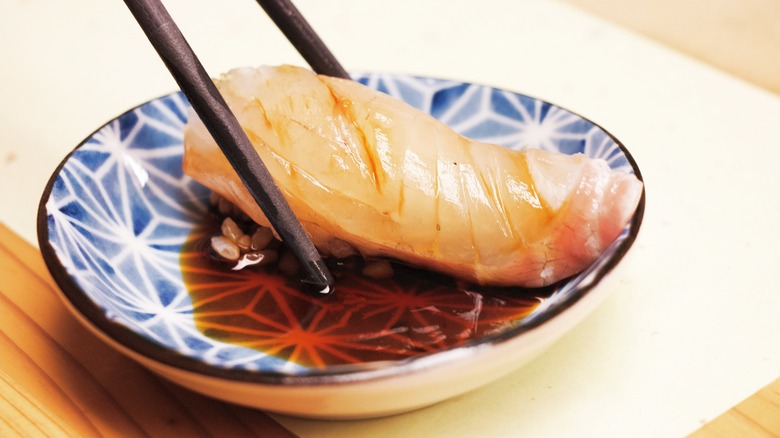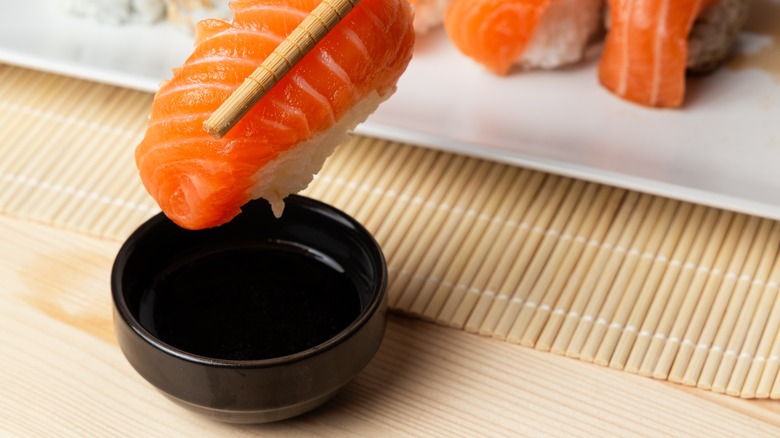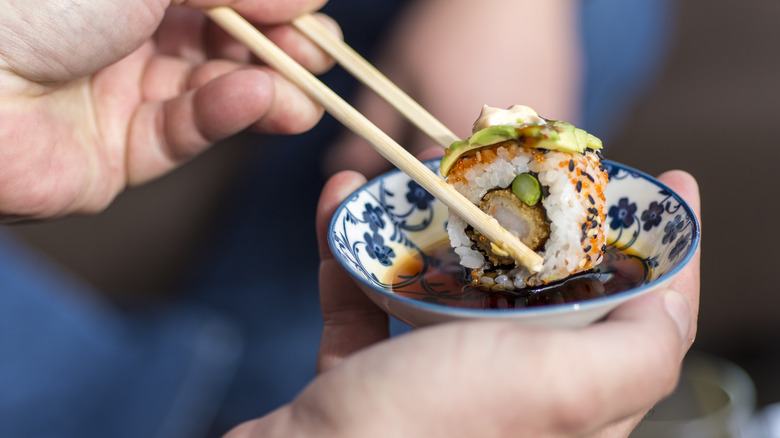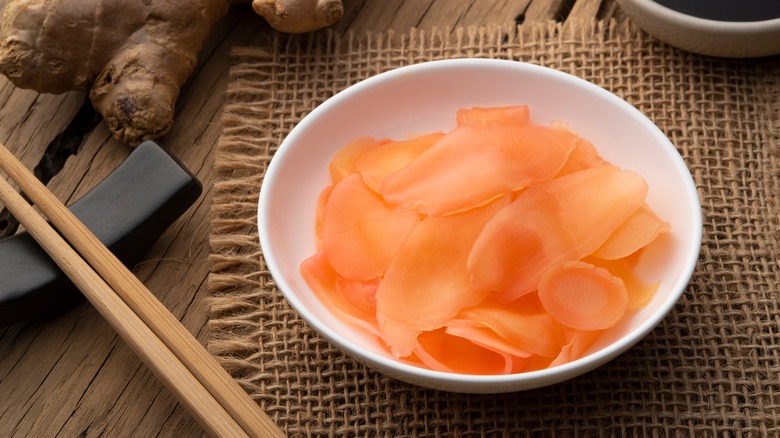It's Time To Stop Drowning Your Sushi In Soy Sauce
Sushi, to me, is one of the greatest foods on earth. It's light, nuanced, and an exercise in textures, simplicity, and flavor. For such a deceptively simple bite composed of vinegar-seasoned rice, topped with seafood (or other types of meat, eggs, or vegetables), it can be incredibly complex — but its delicacy is something to be savored.
As you've experienced, most sushi comes served with soy sauce available on the side, meant to be used for dipping. I'll be the first to admit that I'm not always the best example of dipping sauce restraint, but I've witnessed some pretty egregious applications of the savory liquid. I've seen strangers, friends, and loved ones dunk their sushi to the point where the rice disintegrates into the dipping bowl, and as much as I also love soy sauce, I'm here to stage an intervention and gently let you know that you may in fact, be using too much.
Think about it like this — just because the soy sauce is on the table doesn't mean that you need to douse your sushi in it. Excessive soy sauce use will cover up the taste of the fish and ruin the texture of the rice.
Ultimately how you eat your sushi is up to you. But if you're a sushi-in-soy-sauce-drowner, I recommend you pull back a little, and I have a few tips on how to get the most out of your sushi without overwhelming each bite with sauce.
General guidelines when it comes to dipping nigiri in soy sauce
Nigiri is the type of sushi with a hand-pressed oval of rice, typically topped with a single slice of raw fish. Despite the fact that the rice is on the bottom, I recommend you flip the nigiri upside-down (or slightly on its side), dip it fish side down into the soy sauce, and use just enough so that you can still taste the fish when you eat it. The soy sauce should act as a savory accent to the fish rather than the main flavor; you don't want the soy sauce to hijack the flavor of the topping and the delicately seasoned rice.
Dipping the rice side into the bowl has another negative side effect — it wicks the soy sauce up into the rice, which means you'll get more than you intended. Oftentimes the rice will also crumble into your dipping bowl.
If you're not too confident in your chopstick skills, don't worry — it's perfectly acceptable to eat nigiri with your bare hands. And if your nigiri comes brushed with soy sauce or another dressing already, don't dip it at all. Let the chef's intentions guide your bite. Whether or not you mix wasabi into your soy sauce is up to you, but many sushi chefs frown on the practice, saying it degrades the flavor of both ingredients. Keep in mind that most nigiri is already pressed with a touch of wasabi beneath the fish.
Should you dip makizushi into soy sauce?
Makizushi, commonly referred to as maki sushi, are the type of sushi rolls that are filled, rather than topped. They are most frequently rolled with the nori (seaweed) on the outside, but sometimes the outer layer is rice instead. Here's where things get a little trickier. If the roll already comes pre-dressed with a drizzle of sauce on top, like spicy mayo or thick unagi sauce, I recommend you eat at least one or two pieces of it before you even consider a little dip into your bowl. A lot of these sauces already come packed with flavor and salt, and considering unagi sauce is already soy sauce-based, that soy-on-soy seasoning can be a little intense.
If you do choose to dip, you'll have no choice but to dip the rice portion on the outside of the roll into the sauce. Again, keep in mind just how flavorful and salty soy sauce is, and that the sauce tends to race its way up the rice more than you'd think. Start conservatively; if your roll starts to disintegrate, you'll know you've hit the maximum amount it can handle.
The pickled ginger on the side is a palate cleanser
The pink or white pickled ginger that's served on the side with your sushi is a palate cleanser. That means rather than eat a small sheet of it with a mouthful of sushi, you're meant to eat it between rolls in order to reset your mouth for the next new thing.
Personally, I take it pretty easy with the pickled ginger because if I eat more than a couple shavings of it, the super strong flavor of the ginger absolutely obliterates my tastebuds. Even after taking sips of my drink afterwards, I can still feel the burning sensation from the ginger in my mouth, which is really distracting before I dive into my next round of nigiri. And if I wait for that flavor to die down naturally, my next roll of sushi will have sat out for a while. Sushi is best eaten right away once it's served, and you don't want to let its quality decline by waiting out that ginger burn.
When it comes down to it, it's your meal, you can eat sushi however you like. It's not like I'd yell at you if I saw you in public pouring soy sauce all over your food. But sushi's not typically cheap, and I think it's something to be savored. You can already eat soy sauce at home on anything you like, so why not give sushi a little extra respect and let it shine on its own?



